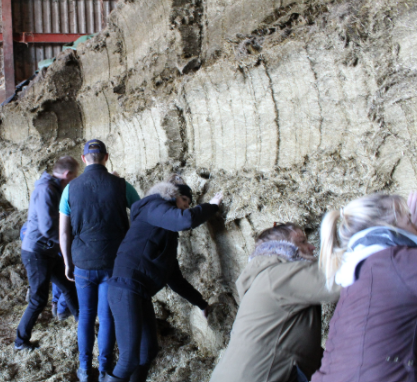The Myerscough College Ag Net Zero Challenge, Lodge Farm
Land management is amongst the largest contributors to climate change and there is an urgency for agriculture to transform from being a net emitter of carbon (CO2e) to a net sequester of carbon (CO2).
Carbon Farm Roadshow #1
Courtesy of Myerscough College
The Myerscough College Ag Net-Zero Challenge is part of The Lancashire Colleges’ Strategic Development Fun Pilot, supporting colleges and local employers to work together to create a skilled workforce for a future low-zero carbon economy.

Farm Profile
Myerscough College’s Lodge Farm in Bilsborrow, near Preston Lancashire were the first hosts of the Ag Net-Zero Challenge Roadshow. They undertook a whole farm carbon audit, including a soil health assessment to identify areas of improvement within their farm business to reduce carbon emissions.
Lodge Farm
Bilsborrow
Near preston
Mixed livestock grazing system
tHE CARBON AUDIT

A carbon audit is an assessment of the emissions of carbon dioxide equivalents (CO2e) produced by each enterprise within a business and, where possible, looks at the sources of sequestration within the business. The carbon audit at Lodge Farm was carried out by Carbon Metrics – a company that specialises in analysing and interpreting existing data and generating a targeted management plan to show how net-zero strategies can be achieved. The farm audit is calculated by using a carbon toolkit. There are currently over 70 toolkits available with no standard industry requirements for data. Therefore, in this case study, we used the average of two carbon audit calculators, Agrecalc and Cool Farm Tool, to produce the results.
Strengths
The farm is currently producing milk with a good carbon footprint of 1.42kg of CO2e per kg of milk. This is due to maximizing efficiency per animal and lowering production. This is a good position to be in before sequestration is considered.
In recent months, the farm has invested heavily in new technologies such as a dribble bar and a harvest lab providing real-time nutrient analysis. These will significantly impact resource and nutrient management by reducing the amount of feed and fertiliser. In addition, the improved resource use can reduce emissions considerably and, as such, will help improve the cost of production in the forage and crop enterprises.
The farm has several smart infrastructure systems in place to minimise the need for human effort and maximise productivity. For instance, the farm’s new calf shed is designed with the latest technology/robotics to provide optimal nutrition for calves. These animals’ high welfare and nutritional needs are considered in every aspect, including automatic feeders that guarantee their daily caloric intake without requiring human intervention.
Areas for Consideration
Nutrition for dairy herd as part of the dairy herd’s diet soya bean meal makes up a large percentage of their daily intake. There could be efforts made to source foods which have lower environmental implications such as substituting soya bean meal for other homegrown proteins with lower embedded carbon emissions.
The farm is in an ideal position to develop its electricity from solar panels. The business could further explore storage options in batteries to allow generated power to be supplied to the farm, for lighting and running the milking parlour, as well as supplying to the grid.
The farm could invest in renewables and look further to reduce fuel and fertilizer usage to reduce the farm’s carbon output significantly.
Carbon Opportunities
Monitor fuel use by the farm’s operations and identify areas to reduce diesel use. With introducing a self-propelled feeder wagon, a good proportion of emissions from running a loading machine such as a telehandler and a second feeder wagon tractor will be partially removed from the farming system, helping reduce the emission considerably.
As part of the farm’s investments, a new self-propelled feeder wagon is being introduced to support dairy and beef herd rationing will help reduce wasted feeds and the amount bought-in feeds for example soya products with a high carbon footprint. This will help improve the efficiency of the diet and reduce emissions and the cost of production.
Benefits for the Business
With the farm’s innovative approach for improving efficiency measures, there is a real opportunity to lead the way towards Net-Zero within large-scale dairy operations.
By using new technology and practices, the farm has a real possibility of lowering the farm’s emissions further.
Sequestration areas such as woodland planting on marginal land or regenerative agriculture practice cropping for dairy feed significantly boosts carbon sequestration.
Soil Management

Lodge Farm lends itself to exceptional grass growth for utilisation across its many enterprises. A soil profile identified some areas of compaction and discussions took place around minimum tillage and the introduction of herbal leys to improve soil health. Ploughing is still practiced and utilises copious amounts of organic matter produced at Lodge farm from the beef unit. The emphasis on whole crop forages has now led to expanded area of grass. This has led to an increase in organic matter and better grass yields from less inputs.
Improved productivity

Lodge Farm is focused on making the rumen more efficient. They provide attention to detail when ensiling and preserving grass silage is critical to producing a good forage. This enables the rumen to run efficiently, maximize the nutrition available in on-farm forages, and reduce bought-in feeds. For the ruminant to function, a good forage should smell (pH), feel (scratch test) and taste good. Ruminants are susceptible to changes in pH, and rumen bugs don’t like inconsistencies, often taking 21 days to adjust to variations in taste. Therefore, Lodge Farm ensures that cattle consistently receive the same silage ph. Grass silage cut too wide or too narrow can either roll in the rumen or pass through the rumen quickly. The width of the mouth is a good guide to silage width with a scratch test to increase saliva. The improvements in rumination mean that fewer feeds will be bought-in, meaning lower emissions.
Subscribe!
Please enter your email below to keep up-to-date with the AG Net-Zero Challenge
